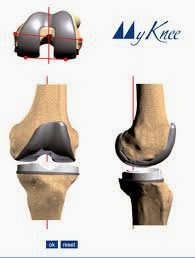What happens during Total Knee Replacement surgery?
In knee replacement surgery, the arthritic or damaged ends of the bone are removed and the bones are capped with artificial surfaces made of metal and plastic. It might sound easy, but it is actually fairly complex. Doctors typically secure joint components to the bones with cement, or medical-grade glue.
Dr. Tyler Goldberg with Texas Orthopedics is one of four international physicians who designed a technique called MyKnee®, which the surgeon uses to perform an accurate total knee replacement and avoid malalignments. Dr. Goldberg partnered with Medacta, a Swiss medical device company, to develop MyKnee. He has also developed other devices and technologies used in total joint replacement that help improve techniques and outcomes. He travels regularly in the United States and internationally teaching these techniques. Dr. Goldberg also serves as the U.S. Medical Director for Medacta USA.
Dr. Goldberg performed the 2nd total knee replacement in the United States using the new MyKnee prosthetic in April of 2010 and has performed more than 600 since then. Worldwide, more than 15,000 MyKnee procedures have been performed to date.
How does using a MyKnee Prosthetic help with my surgery?
MyKnee cutting blocks are anatomical pre-manufactured cutting blocks specifically designed for a single patient. A CT scan is performed on the patient before surgery, which is used to plan the procedure before the patient arrives to the operating room. Based on the planning, the MyKnee cutting blocks are made to fit exactly to the patient’s bone and guide the bony cuts. With this technology, surgeons and patients can be confident of the outcome due to the planning performed prior to the surgery and the accuracy of the blocks in surgery. More accurate cuts hopefully make for a better, more aligned knee replacement.





